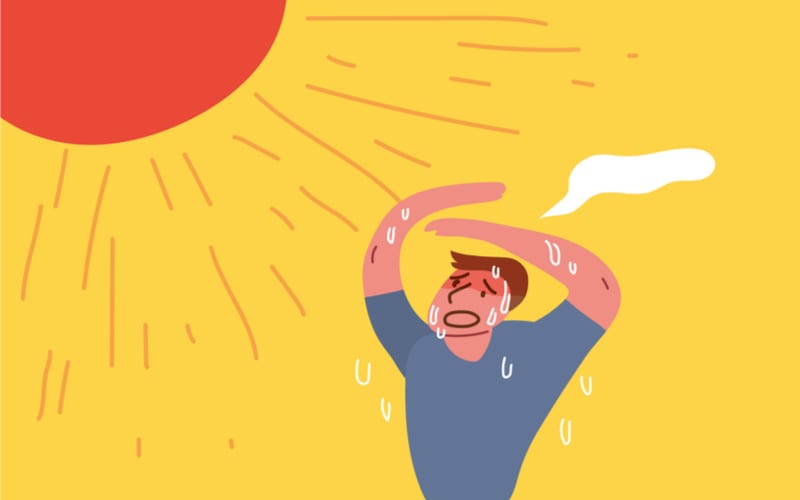Depending on where you are in the world, the approach of summer can mean a variety of things. For those who live in climates with harsh, long winters when the sun is virtually non-existent, summer is a time to shed the layers and enjoy the rays that will soon be hidden for months on end. Conversely, summers in equatorial climates will differ from the usual swelter with only slightly higher temperatures and humidity levels. In New Orleans, LA, where TPN.Health is headquartered, the months of May through September are always intense with temperatures hanging in the upper 80s to mid-90s on a normal day and humidity levels that make you feel like you’re breathing water.
A breadth of research over the years has shown that extreme heat is linked to mood dysregulation in the form of depressive symptoms along with higher suicide and violence rates (Cooper, 2019). Similarly, a 2018 literature review exploring the biological mechanisms at work during exposure to extreme heat notes neuroimaging studies evidencing that heat-exposure negatively affects one’s ability to handle cognitive conflicts (Lõhmus, 2018). From this observation, the review offers that high temperatures have the potential to worsen symptoms in people who already experience regular behavioral health disruptions (Lõhmus, 2018). Jarring as it can be, the new air that summer brings is just one part of this annual seasonal shift that can affect how folks think and behave.
The National Institute of Mental Health (NIMH) defines Seasonal Affective Disorder (SAD) as a seasonally dependent type of major depression that occurs for a minimum of two years (NIMH 2016). Most often associated with the winter season, it affects between 4% and 6% of the U.S. population (Griffin, 2019). However, around 1% of the total U.S. population will experience SAD in the summertime (Ducharme, 2018). While winter SAD symptoms include hypersomnia, increase in appetite, and lethargy, people with summer SAD are more likely to experience a decrease in appetite, insomnia, and anxiety (NIMH, 2016).
Just as sunlight deprivation can contribute to disrupted sleep patterns during winter, the longer periods of sunlight can do the same in the summer. Prolonged exposure to the light can contribute to summer SAD insomnia by decreasing melatonin production and disrupting the body’s sleep-wake cycle (UCI 2019). A not-so-obvious environmental shift during the summer is pollen-count. In fact, several studies over the years have explored the relationship between seasonal allergens and significant mood and affect changes (Akram et al., 2019; Guzman et al., 2007). Through a self-report measure, Guzman et al. (2007) found that participants’ moods worsened during times of higher pollen count. Further exploration suggests that seasonal pollen exposure could be associated with non-winter SAD (Guzman et al., 2007). Likewise, women, people who already have major depression or bipolar disorder, and people with a family history of depression have a higher likelihood of being diagnosed with SAD (NIMH, 2016).
A WebMD article notes that changes in wardrobe and routine can also bring to light a more common struggle of summertime, that is, comparison. As clothing layers shed, collective attention shifts to body image. The need to fit specific body standards affect the type of attention a person gives their body and could result in a self-deprecating orientation. Similarly, if one already experiences body image issues, common in eating and feeding disorders, wardrobe changes during the summer season have the potential to exacerbate these. The urge to play the “shoulda, coulda, woulda” game of comparison can also strike when routines change. Many people, such as students and teachers, go from the structure of work and school to having all the time in the world to fill as they please. Even those who don’t get a summer break will feel the draw of summer activities and want to soak in the fun. The season, much like other holiday times, can come with the pull to fill up that calendar and the fear of missing out on all the right activities.
As the new season approaches, stay tuned for TPN.Health digital panels and CEU opportunities! Click here to create your TPN.Health clinical profile and begin connecting in THE trusted digital referral network.
References:
Akram, F., Jennings, T. B., Mohyuddin, H., Dagdag, A., Stiller, J., Brenner, L. A., . . . Postolache, T. T. (2019). T79. Mood Worsening on Hot Days and High Pollen Days in the Old Order Amish With Summer Type SAD. Biological Psychiatry, 85(10). doi:10.1016/j.biopsych.2019.03.402
Cooper, R. (2019, July 30). The Impacts of Extreme Heat on Mental Health. Retrieved May 28, 2020, from https://www.psychiatrictimes.com/climate-change/impacts-extreme-heat-mental-health
Griffin, R. (2019, August 28). Summer Depression: Causes, Symptoms, and Tips to Help. Retrieved May 28, 2020, from https://www.webmd.com/depression/summer-depression
Guzman, A., Tonelli, L. H., Roberts, D., Stiller, J. W., Jackson, M. A., Soriano, J. J., . . . Postolache, T. T. (2007). Mood-worsening with high-pollen-counts and seasonality: A preliminary report. Journal of Affective Disorders, 101(1-3), 269-274. doi:10.1016/j.jad.2006.11.026
Lõhmus, M. (2018). Possible Biological Mechanisms Linking Mental Health and Heat—A Contemplative Review. International Journal of Environmental Research and Public Health, 15(7), 1515. doi:10.3390/ijerph15071515
NIMH (The National Institute of Mental Health) (2016). Seasonal Affective Disorder. Retrieved May 28, 2020, from https://www.nimh.nih.gov/health/topics/seasonal-affective-disorder/index.shtml
Ducharme, J. (2018, June 05). Seasonal Affective Disorder Can Happen in the Summer. Retrieved May 28, 2020, from https://time.com/5287625/summer-seasonal-affective-disorder/
UCI Health (30 July, 2019). Summertime Blues Are Really a Thing. Retrieved May 28, 2020, from, https://www.ucihealth.org/blog/2019/07/summer-sad
Image Credit: https://www.tokyoweekender.com/2018/08/tokyo-2020-olympics-beating-the-summer-heat/
